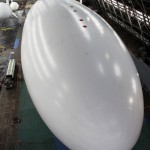By Noah Shachtman
After spending more than $140 million, the Air Force is poised to pull the plug on its ambitious project to send a king-sized, all-seeing spy blimp to Afghanistan. Which is a bit of a strange move: Not only is the scheduled first flight of the 370-foot-long “Blue Devil Block 2” airship less than six weeks away, but just yesterday, a top Air Force official bragged to Congress about the blimp’s predecessor, the “Blue Devil Block 1″ program. In other words, the Air Force is set to ground its mega-blimp spy ship before it even gets off the ground — literally.
Not long ago, Blue Devil and its kind were being pushed as the future of aerial surveillance. Instead of a drone’s single sensor, Blue Devil would employ an array of cameras and eavesdropping gear to keep tabs on entire villages for days at a time. And with so much space aboard the airship, racks and racks of processors could process the data generated by those sensors in the sky, easing the burden on intelligence analysts currently overloaded by drones’ video feeds.
Now, that lighter-than-air future could be in jeopardy, thanks to a series of schedule delays, technical complications and, above all, inflated costs. But it’s not just Blue Devil that’s in trouble. The Navy just deflated its MZ-3A blimp. The Army’s Long Endurance Multi-Intelligence Vehicle airship, which was supposed to be in Afghanistan by now, has run into significant development roadblocks as well. Blimps’ status as the Next Big Thing in high-flying spycraft is in jeopardy.
Yet there have been some encouraging signs for the overall Blue Devil effort. Block 1 of the program — a similar suite of coordinated sensors, mounted on modified executive planes — had became a proven method for shortening insurgent bomb-makers’ lives in Afghanistan. “Warfighter feedback on the situational awareness provided by Blue Devil Block 1 has been overwhelmingly positive,” Steven Walker, the Air Force’s deputy assistant secretary for science and technology, told a Congressional panel on Wednesday. “Since December 2010, Blue Devil ISR [intelligence, surveillance, and reconnaissance] has been instrumental in identifying a number of high value individuals and improvised explosive device emplacements.”
But the next phase of Blue Devil was ambitious, and with that ambition came complications. Schedules slipped, as the airship’s tail fins came in overweight and subcontractor Rockwell Collins realized that the avionics of an airship were more complex than they had originally thought. The Argus network of spy cameras, which could oversee 64 square kilometers at once, couldn’t be integrated in with the rest of the sensor; the blimp-builders had to settle for an Angel Fire camera pack, which could only look at a mere four square kilometers at a time. Then a giant laser, meant to beam all that surveillance data to the ground, had to be put aside. It couldn’t be custom-built fast enough.
Meanwhile, the Federal Aviation Administration insisted on certifying the blimp — a process no drone airplane had undergone — since the blimp was optionally-manned, and since it was going to have to fly over the United States, at least in tests. Trying to handle it all was Mav 6, a smallish start-up with major connections — its CEO is the former chief of Air Force intelligence — but no experience in handling a project with so many moving parts. “They were in over their heads,” says a senior Pentagon official. A scheduled October 15, 2011 first flight was pushed back and back again, and is now slated for April 15.
But the real body-blow for the program came when the Air Force’s special intelligence program office, known as “Big Safari,” issued its estimate of how much it was going to cost to fly the blimp in Afghanistan. Mav 6 CEO and retired Lt. Gen. David Deptula, who until in 2010 served as the head of Air Force intel, insisted all along that Blue Devil would be dirt-cheap to operate and maintain. Because of all its on-board processing and its lengthy stints in the air, it would cost a fraction of what it would cost to keep an equivalent number of spy drones in the sky, maybe $45 million. But Big Safari had questions about how durable this experimental aircraft would really be, and how vulnerable it might be to insurgent attack during refueling or repair. Their estimated operating costs: $188 million.
Big Safari, which only recently became comfortable with outfitting drones instead of manned planes, was always skeptical of the Blue Devil blimp. The whole project was basically rammed down the Air Force’s collective throat in 2010 by a task force that reported directly to the Secretary of Defense. And as soon as Big Safari got the project, it “promptly proposed wholesale changes to the program — an entirely different platform, continued use of legacy cameras, and different SIGINT [signals intelligence] sensors,” a Senate Armed Services Committee report noted last year. The cost estimate only reinforced that skepticism.
The Air Force insists it hasn’t yet made a formal decision about the fate of the massive blimp. But the service’s budget for next year contains no money to develop or operate the blimp — a telling sign. What’s more, Air Force spokesperson Jennifer Cassidy acknowledged in an email that “as a result of budget and technical challenges, the Air Force authorized a 90-day temporary work stop on the sensor payload integration” — the blimp’s network of cameras and listening devices — until the service “determine(s) the most prudent course of action.” Till then, the Air Force’s plump, floating future remains tethered to the ground.
Source: Wired.com





